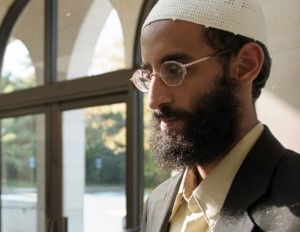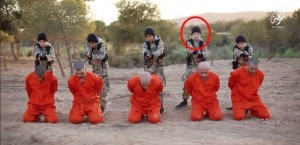* James Kitfield
They were once considered “Lions of the Caliphate,” the vanguard of an unprecedented army of roughly 40,000 foreign fighters from around the world who were drawn to the black banner of the Islamic State of Iraq and Syria (ISIS). When U.S.-backed Arab and Kurdish forces tightened the noose around ISIS’s self-proclaimed capital of Raqqa this past summer, many of those remaining foreigners tried to slip through the siege in makeshift convoys, often with families and other civilians in tow as “human shields.”
(British Muslim convert Sally-Anne Jones dressed as a nun in a photo circulated online, and her husband, British jihadist Junaid Hussain, in his Twitter photo)
Some blended in with a stream of refugees fleeing southeast to dusty towns along the Euphrates River. A contingent of French-speaking jihadists were reportedly besieged in Deir al-Zour, and a hardcore group of British fighters made it to al-Mayadin. Some have made it as far as al-Bukamal on the Syria-Iraq border, where top ISIS leaders are thought to have sought refuge. Still other foreign fighters are reportedly stranded on the northern border in the city of Idlib, unable to bribe their way into Turkey. A number of Britons and at least one American tried to slip through Kurdish lines and were captured and transferred to coalition intelligence services
One member of the ISIS foreign fighter exodus was of particular interest to U.S. and British intelligence agencies. Since ISIS’s Phoenix-like rise from the ashes of the Syrian civil war in 2014, counterterrorism experts have been especially alarmed at the group’s social media savvy and ability to recruit and inspire Western jihadists online. In Britain alone, more than 800 mostly young men joined the group, and many others professed fealty. Not coincidentally, ISIS has claimed credit for a string of bloody jihadi attacks in Great Britain this year, including the March vehicle attack on the Westminster Bridge and stabbing outside of Parliament that killed four and injured more than 50 others; the suicide bombing in Manchester at an Ariana Grande concert that killed 22 people, many of them teenagers and children; and a van attack and stabbing rampage by three jihadis near the London Bridge in June that killed eight people and injured more than 40 others.
So when surveillance indicated that one member of the Raqqa foreign fighter exodus was a woman known as “the White Widow,” U.S. counterterrorism forces swung into action. Sally-Anne Jones was a middle-aged Briton and former punk rocker whose prowess in recruiting British fighters and attempts to inspire attacks on her homeland were local legend. Jones had been married to Junaid Hussain, also a Briton, an accomplished hacker who had risen to head ISIS’s cyber operations, and was one of Britain’s most wanted terrorists before he was killed in a U.S. drone strike in 2015. Somewhere along the Syria-Iraq border last June, the scream of another Hellfire missile rent the sky, and U.S. intelligence officials informed their counterparts in Britain’s security services that Sally-Anne Jones had met the same violent end as her late husband. Tragically, her 12-year-old son, Jojo, was also believed to have been killed in the blast.s
The whirlwind romance, trail of terror and violent deaths of Junaid Hussain and Sally-Anne Jones trace the arc of ISIS’s own meteoric rise and spectacular collapse as its once mighty “caliphate” crumbles in Iraq and Syria. The jihad that led Junaid and Jones and tens of thousands of other foreign fighters to Syria was unique in the annals of terrorism. In its savvy use of social media and the internet to recruit fighters and inspire atrocities by homegrown “lone wolves,” ISIS far surpassed al-Qaida. It built on the lessons of the propaganda master Anwar al-Awlaki, an extremist American cleric and leader of al-Qaida in the Arabian Peninsula who was killed by a U.S. drone in 2011. ISIS even called its external operations group tasked with recruiting and propaganda “the Awlaki Brigade.”
(Anwar al-Awlaki at a mosque in Falls Church, Va., Oct. 4, 2001)
But ISIS leader Abu Bakr al-Baghdadi’s dark vision also included the seeds of its own destruction. His medieval caliphate was far from the promised Islamist paradise, and its circus of beheadings, torture and sexual enslavement steeled the will of the civilized world against it, and gave the U.S.-led coalition a known address to target. Continuing terror attacks directed or inspired by ISIS led to an unprecedented level of intelligence-sharing among partners in the anti-ISIS coalition. Largely as a result, a majority of foreign fighters met the same fate as Junaid Hussain and Sally-Anne Jones.
“Safe haven is always high on the list of a terrorist organization’s sources of strength, and ISIS exercising state-like dominion over much of the territory of Iraq and Syria, with all its economic and energy resources, was in many ways the ultimate safe haven. That was incredibly dangerous from a counterterrorism perspective,” Nicholas Rasmussen, director of the National Counterterrorism Center, said in an exclusive interview with Yahoo News. “Combine that with ISIS’s unique ability to attract fighters from outside Iraq and Syria, which was far beyond anything al-Qaida ever aspired to, and suddenly we were dealing with a mass terrorist movement.”
While U.S. officials always believed that the U.S.-led coalition would eventually recapture ISIS-held territory, Rasmussen said, they worried that as the caliphate collapsed, the tens of thousands of foreign fighters would return to their homelands to wreak havoc on a mass scale. “We assumed the foreign fighters that flowed out from the caliphate would roughly equal the numbers that joined ISIS, and we have rethought that analysis. We now think most of them will stay and fight and die in the caliphate. That’s good news. The bad news is that some small number are likely to make their way out, and these individuals may have a unique skill set and networks back home that will enable them to carry out attacks in their homelands.”
It’s difficult to overstate the alarm that Western counterterrorism officials felt in the summer and fall of 2014. After ISIS’s irregular, black-clad army had overrun much of northern Syria and Iraq in one of the most improbable military offensives in history, its leader al-Baghdadi appeared in the Great Mosque of al-Nuri in the Iraqi city of Mosul. There on June 29, 2014, he proclaimed himself the caliph of ISIS’s new homeland for true Islam, and that message resonated deeply in the global jihadi movement, whose networks began humming with extraordinary activity. Intelligence officials were soon tracking roughly a thousand foreigners who joined ISIS each month, eventually from more than a hundred different countries.
(This image from a video posted on a militant website shows Abu Bakr al-Baghdadi speaking at the Great Mosque of al-Nuri in Mosul, Iraq, on June 29, 2014)
The thousands of Europeans who were drawn to the caliphate and could travel to the United States without visas were of special concern. For years, U.S. counterterrorism officials had recognized Europe as an acute terrorism vulnerability. There are pockets of poorly assimilated Muslim youth in ghettoes scattered throughout Europe, from Moss Side in Manchester, England, to Molenbeek in Brussels. Alienated young men from these neighborhoods were often radicalized by well-known extremist preachers and imams who took advantage of Europe’s liberal free-speech laws. In the recent report “For Caliph and Country: Exploring How British Jihadis Join a Global Movement,” researchers for the Tony Blair Institute for Global Change examined the biographies of 113 men and women who embraced jihad, finding that 67 percent had ties to just six radical Islamist preachers or facilitators.
In the United States post-9/11 reforms had eliminated many of the obstacles to intelligence-sharing among U.S. intelligence and law enforcement agencies. Intelligence sharing in Europe, however, remained fractured and disjointed among the European Union’s 28 countries and myriad national, provincial and local agencies. The EU’s porous external borders and lack of internal border controls, its proximity to the battlefields of the Middle East and an influx of more than a million mostly Muslim refugees between 2014 and 2015, primarily from the wars in Syria and Afghanistan, all added to the volatile mix.
In the summer and fall of 2014, the sense of alarm increased after a man dressed in black, his face hidden behind a mask and speaking with a British accent, began appearing in a series of gruesome beheading videos. On August 19, 2014, the group’s media arm released a video showing him murdering American journalist and ISIS hostage James Foley. A string of similar beheading videos followed throughout the fall, depicting the murders of six more hostages. The knife-wielding terrorist at the center of the bloody executions was nicknamed “Jihadi John” by the press, and his British-accented accomplices were dubbed “the Beatles” by some of the hostages. Their reign of terror provoked one of the most intense terrorist manhunts since the death of Osama bin Laden in 2011.
“The appearance of Jihadi John in videos of all these people having their heads cut off was a watershed moment, because they really were damn shocking, and the British especially were trying to wrap their heads around the fact that so many of their disenfranchised youth were showing up in Syria with ISIS,” said a U.S. intelligence source. “The British government poured every resource you can imagine into identifying this guy and his accomplices, and getting after them. It was a very big deal, because everyone was worried about what the hell we were going to do when these ISIS foreign fighters returned home.”
(A militant identified by the Washington Post as a Briton named Mohammed Emwazi -aka Jihadi John-brandishes a knife in this image from a 2014 video)
The United States has long enjoyed a close intelligence-sharing relationship with the other “Five Eyes” countries (Britain, Australia, New Zealand and Canada), and none was closer than with Britain’s MI6 (foreign) and MI5 (domestic) intelligence services. Jointly, they set out to catalogue all of the foreign fighters who had joined ISIS, partly in hopes of identifying Jihadi John and his fellow travelers. During that intelligence operation, they uncovered evidence of the unlikely May-September romance of 20-something Junaid Hussain and a middle-age Sally-Anne Jones.
A Birmingham-born hacker of Pakistani descent, Hussain was already on the radar of Britain’s MI5. Operating under the moniker “Trick” in a hacker group that called itself “Team Poison,” Hussain spent six months in prison in 2012 for hacking former British Prime Minister Tony Blair’s address book and publishing its contents online. Team Poison also hacked the MI6 antiterror hotline, during which Trick can be heard laughing and proclaiming “You’re being phone-bombed right now, mate.” In 2013, Hussain jumped bail and fled to Syria to join ISIS, but not before starting a torrid romance with Jones, a mother of two from Kent who dabbled in witchcraft. The intercepted telephone conversations of these supposedly pious Islamic warriors were enough to make a sailor blush, said one source. The two married and Sally-Anne Jones followed her husband to Syria with her then 8-year-old son JoJo in tow.
Based largely on their computer hacking and social media skills, Hussain and Jones rose quickly through the ranks of ISIS foreign fighters. He became head of the group’s “cybercaliphate” operations, and she was a gifted recruiter and propagandist for English-speaking audiences. According to intelligence sources, Junaid hacked into the computer system of U.S. Central Command, and published on jihadi websites the names and addresses of U.S. service members living overseas as part of a “doxing” attack. He was also linked to Elton Simpson, one of two ISIS-inspired gunmen killed as they tried to stage a massacre at an event in Texas displaying controversial cartoons of the Prophet Mohammed.
For her part, Jones recruited women to ISIS by extolling the virtues of the caliphate and its fearsome warriors, and sought to inspire “lone wolf” attacks in Britain. She routinely issued threats through posted messages such as “You Christians all need beheading with a nice blunt knife and stuck on the railings at Raqqa. … Come here, I’ll do it for you.”
“ISIS is good at spotting talent, and they quickly recognized that Hussein’s hacking skills and connectivity to the hacking underworld were valuable commodities, as was Jones’s recruiting and propaganda skills on social media,” said an intelligence source. “In that sense, Hussain and Jones became poster children for the ISIS narrative, and they were given far more clout in the organization than most Westerners.”
Remarkably, another ISIS-inspired love story sent alarms ringing through U.S. counterterrorism networks at that time. In 2014, the FBI had had another Western foreign fighter under surveillance named Denis Cuspert, a former German rapper who went by the rap name “Deso Dogg.” A fake video Cuspert produced purportedly showing U.S. soldiers raping a Muslim woman reportedly inspired an attack on four U.S. service members in Germany in 2011. In the summer of 2014, Cuspert emerged as an ISIS recruiter and cheerleader in Syria, and ISIS videos depicted him holding the severed head of an executed ISIS prisoner.
(Rapper Denis Cuspert, aka “Deso Dog,” in Berlin in 2004)
In June, the FBI discovered that Daniela Greene, one of its translators who held a top secret clearance and was monitoring Cuspert’s online activities, had disappeared while on foreign travel to Germany. She soon reappeared having secretly traveled to Syria to marry Cuspert. As CNN reported, on Aug. 1, 2014, a little over a month after Greene disappeared, federal authorities issued a secret warrant for her arrest, stating that the “defendant was at large in Syria or Turkey in the company of the leader of a terrorist group.” Within weeks of marrying Cuspert, Greene had second thoughts about life in the caliphate and fled back to the United States, where she was immediately arrested.
Meanwhile, any doubts about the depravity at the center of Junaid Hussain and Sally-Anne Jones’ love story were dispelled when an ISIS video emerged showing her son JoJo executing a hostage with a gun. He was 12 years old.
In many ways, the terrorist attack in Paris which killed 130 people on November 13, 2015, crystalized all fears about the ISIS foreign fighter threat. The ringleaders were Western Europeans who had traveled to Syria and received training and support from experienced ISIS leaders. Some of the cell members had successfully infiltrated back into Europe by hiding among tens of thousands of Muslim refugees. Once back in Europe, they activated known extremist and criminal networks, operating largely out of the Muslim ghetto in Molenbeek, Brussels. The same hardened ISIS cell which attacked Paris was also responsible for the March 22, 2016, suicide bombing attacks in Brussels that killed 32 civilians and injured more 300 others. Of 40 terror attacks in Europe since 2015, only three have been perpetrated by foreign fighters, according to U.S. counterterrorism data. But those three have accounted for half of all the resulting casualties.
“The Paris attack was a nightmare, and of particular concern because of the direct connectivity between ISIS and the perpetrators. It had all the hallmarks of a centrally planned, organized and directed attack involving top ISIS leadership,” said NCTC’s Rasmussen. The attack prompted Western countries and intelligence services to redouble efforts to identify every individual who had traveled to Syria and Iraq to join ISIS, he said, and to put their names into terrorist data bases and watch lists. “We always anticipated that Western fighters who flowed to the conflict zone in Syria would return home at some point, so we spent the first few years on data collection and identification of these people. I feel confident in that work because of extraordinary and really unprecedented cooperation with a lot of our counterterrorism partners around the world.”
A central pillar of that unprecedented cooperation was Operation Gallant Phoenix, a U.S.-led initiative to enable the widespread sharing of intelligence on ISIS foreign fighters that started out with eight countries and expanded to more than 20. “Gallant Phoenix allows allied nations not only to share intelligence on the foreign fighter threat, but also to get that information back to their law enforcement and homeland security agencies so they have visibility on the movement of foreign fighters in order to deal with this challenge,” Gen. Joseph Dunford, chairman of the Joint Chiefs of Staff, told the author in an interview last summer.
Under the direction of Defense Secretary Jim Mattis this year, the U.S.-led coalition in Iraq and Syria also adopted a new “annihilation” strategy of completely surrounding ISIS strongholds before attacking, to keep enemy fighters from escaping.
“When Secretary Mattis looked at our anti-ISIS campaign, he concluded that in some instances we were essentially just pushing the enemy from one location to another. He asked me and the military chain of command to make a conscious effort not to allow ISIS fighters to just flee from one location to another, but rather to deliberately seek to ‘annihilate’ the enemy … and our commanders on the ground have tried to meet that goal,” said Dunford. “But I would never claim that means that all enemy fighters are being killed. One tactic they adopted is to mix in with the civilian population, and that makes targeting them very difficult.”
(Chairman of the Joint Chiefs of Staff Marine Gen. Joseph F. Dunford Jr., left, and U.S. Secretary of Defense Jim Mattisanswer questions during a Pentagon briefing, May 19, 2017)
Other post-Paris reforms include Europol creating the European Counter Terrorism Center in January 2016 to serve as a clearinghouse for intelligence modeled after the U.S. National Counterterrorism Center. Since 2014, more than 60 countries have also passed new laws making it illegal to join or support terrorist groups, many mirroring the U.S. law against “materially supporting” terrorists groups. Meanwhile, better identification and tracking of ISIS foreign fighters made it much more difficult for them to slip back into Europe undetected.
“There has been a huge shift in the willingness of European countries to share intelligence on the terrorist threat over the past two years, and we are now checking people entering or exiting Europe against common databases of terrorists,” said a senior European Union official, who asked not to be identified in order to speak freely about intelligence matters. “Not even the United States checks exits.”
The result is that an ISIS foreign fighter army of roughly 40,000 at its peak has declined to between 1,000 and 1,500, according to U.S. counterterrorism officials. More than 20 ISIS leaders have been successfully targeted, including Abu Mohammad al-Adnani, the senior ISIS spokesman who is believed to have authorized the terror attacks in Paris and Brussels, killed in Aleppo in September 2016. Prominent foreign fighters caught in that lethal dragnet include Jihadi John, the British militant and executioner whose real name was Mohammed Emwazi, killed in a drone strike in November 2015 — and Hussain and his wife, Sally-Anne Jones. Her son is believed to have been killed with her.
“We take the threat ISIS’s British fighters will return as the group’s territory is squeezed very seriously, and we have plans to make sure those who do return are arrested. The numbers are small, but very important,” Amber Rudd, the British home secretary, told the author at a recent event sponsored by the Washington think tank New America. Though the Manchester bomber is thought to have received training by an ISIS affiliate in Libya, the other ISIS-inspired attacks in Britain this year were perpetrated by homegrown terrorists radicalized online or in local mosques. Early this year, British security services revealed that fully 3,000 people with links to ISIS or other Islamist extremist groups were under active investigation, with 20,000 others categorized as posing a “residual risk.” “For both Britain and the United States, we believe the future threat will mostly come from homegrown radicals,” said Rudd.
For their part, U.S. counterterrorism officials realize that it took only a relative handful of experienced ISIS foreign fighters to perpetrate the terrorist “spectaculars” in Paris and Brussels. Of the more than a thousand foreign fighters they now estimate will return to the West, how many will possess the skills and networking contacts of an Abdelhamid Abaaoud, the Belgian who masterminded the Paris attacks? How many will embody the commitment to a nihilistic cause of a Sally-Anne Jones, who turned her own young child into an unwitting executioner and human shield? As the Washington Post recently reported, hundreds of female immigrants to the Islamic State are now seeking to return to their native countries with their children, raising fears of another wave of terror attacks.
(A boy believed to be Jojo Dixon, son of Sally-Anne Jones is seen (circled) in this Islamic State propaganda video before executing a Kurdish fighter)
“I actually think the West collectively did a good job of cataloguing who these ISIS foreign fighters were, where they were from, and when might they try and come home, but this business is still more of an art than a science,” said Russell Travers, the deputy director of the National Counterterrorism Center. “Most will die in the caliphate, but there will still be a trickle of foreign fighters with training in weapons and explosives that return, and they remain a concern. Even if they are arrested and put in jail, the chances are that the sentences will be relatively light in some cases, and they will be out on the streets in a few years. So this is going to be recurring threat.”
In June Sally-Anne Jones and Jojo reportedly made it almost to the Syrian border town of Mayadin, the last redoubt of the crumbling ISIS caliphate. Britain’s willingness to approve lethal attacks on its own citizens had already been established with the deaths of her husband, Hussain, and of Jihadi John in 2015, both killed in joint U.S.-U.K. counterterrorism strikes. Intelligence operatives called those operations London’s “Awlaki moment,” referring to a threat that drives a democratic government to issue an extrajudicial death sentence to its own citizens, albeit traitorous ones. The United States crossed that Rubicon in 2011, when it targeted U.S. citizen Anwar al-Awlaki.
Last June, the same shadow that stalked her husband was tracking Sally-Anne Jones. ISIS routinely uses civilians as human shields as part of its trade craft, and Jones may have thought that her 12-year-old son was insurance against a lethal strike. Certainly under the United Nations charter Jojo was too young to be classified as a soldier. The “rules of engagement” for lethal drone strikes are one of the most closely guarded government secrets, and it’s unclear whether U.S. counterterrorism officials were aware of his presence. Much as Anwar al-Awlaki’s 16-year-old son Abdulrahman was killed as “collateral damage” in a subsequent U.S. drone strke, Jojo reportedly disappeared in the blast cloud of a missile aimed at Sally-Anne Jones.
(Tribesmen stand on the rubble of a building destroyed by a U.S. drone air strike that targeted suspected al-Qaida militants in Azan, a southeastern province of Yemen, Feb. 3, 2013)
“That operation left a bitter aftertaste, because a lot of us hoped to somehow get Jojo out of Syria alive,” said an intelligence source. “I have a big issue with a parent who would not only drag their young child into the perverse world of the Islamic State, but also let someone put a gun in his hand and turn him into an executioner. The world is definitely better off without someone like Sally-Anne Jones in it, but I still wish we could have saved Jojo before they pushed him over that threshold.”
* James Kitfield is a senior fellow at the Center for the Study of the Presidency and Congress
Source: yahoo.com
Ask me anything
Explore related questions














